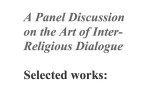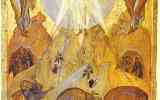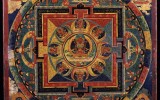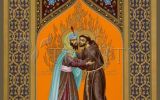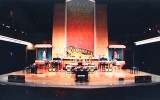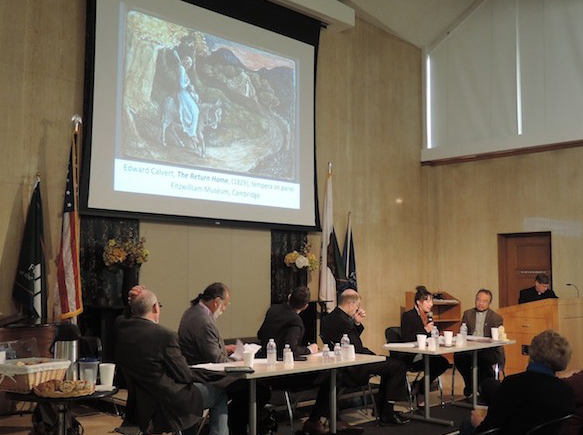SUNDAY, MAY 17, 10:45AM at Xavier Hall, Fromm – A PANEL DISCUSSION ON THE ART OF INTER-RELIGIOUS DIALOGUE
The panel discussion examined what it means to present an exhibition of artworks that focus on Interfaith Dialogue. Six panelists were all asked to select two artworks from any time period that they thought best represented Interfaith. The talk was moderated by Father James Blaettler, S.J., Manresa Gallery Director. The panelists include:
Prof. Thomas Cattoi is Associate Professor of Christology and Cultures at the Jesuit School ofTheology at Santa Clara University, which is part of the Graduate Theological Union in Berkeley, California. He also holds the Dwan Family Chair in Ecumenical and Interreligious Dialogue. He is the author of Divine Contingency: Theologies of Divine Embodiment in Maximos the Confessor and Tsong kha pa (Gorgias Press, 2009) and Theodore the Studite: Writings on Iconoclasm (Ancient Christian Writers, Newman Press, 2014), and has published articles in early Christian theology and Buddhist-Christian dialogue. He edited of Perceiving the Divine Through the Human Body: Mystical Sensuality (Palgrave Macmillan, 2011), Many Tongues, One Spirit: Local Ecclesiologies in Dialogue (Solstice, 2013), and Death, Dying and Mysticism: The Ecstasy of the End (Palgrave, 2015). He is the editor of the journal “Buddhist-Christian Studies” and is currently working on a book project exploring the relevance of early Christian theology for contemporary interreligious dialogue.
Deacon Steven Herrera was ordained a Deacon in the Diocese of San Jose in 2006. He currently serves as a board member of the Silicon Valley Interfaith Council (SVIC) in San Jose. Steve currently teaches a class to high school seniors entitled Religion and Globalization which focuses on interfaith dialogue. He has also conducted immersion trips to the Navajo and White Mountain Apache Reservations and to New Mexico for Catholic and Buddhist adults. Steve is currently involved in Co-directing the Teen Interfaith Leadership Council in San Jose. This group involves a diversity of teens of various religious traditions and involves an immersion trip to New Mexico to engage in interfaith dialogue and to learn about various religious traditions in New Mexico. For the last 39 years he has been teaching Religious Studies to high school students.
Prof. Kathryn Barush is Assistant Professor of Art History and Religion at the Graduate Theological Union and the Jesuit School of Theology. She received a D.Phil. and M.St. in the History of Art and Visual Culture from the University of Oxford, which was followed by a 3-year position as Postdoctoral Research Associate at the Center for Advanced Study in the Visual Arts at the National Gallery of Art in Washington, D.C. Previously, she worked as a curatorial assistant at the Yale University Center for British Art and interned at the Albright-Knox Art Gallery.
Prior to commencing graduate work, Dr. Barush had the opportunity to pursue a comparative study of painting and pilgrimage in the Buddhist and Christian traditions with the generous support of a Thomas J. Watson Fellowship. She conducted field research over the course of a year in working scriptoria and archives in the U.K., Tibet, India, and Greece.
Rev. Anh Tran, S.J. is the Assistant Professor of Historical and Systematic Theology at JST, Professor Tran teaches core courses in systematic theology and interreligious studies. His teaching interests include ecclesiology, missiology, theology of religions, interreligious dialogue between Christianity and East Asian religions, theological anthropology, comparative theology, Asian theologies and Christianities, Jesuit mission in East Asia and healthcare ethics. Professor Tran’s research interests involve ecumenism, intercultural dialogue, comparative religion/theology, Asian theology and Christian missions in Asia.
Cross-trained in various fields from electrical engineering to medical ethics to theology, Professor Tran enjoys “being a bridge for students and colleagues from various academic fields, cultures, institutions and religions.”
Rev, Antoni J. Ucerler, S.J. is the Director and Associate Professor at the Ricci Institute for Chinese-Western Cultural History.He is also Fellow of East Asian Studies at Campion Hall, at the University of Oxford. He teaches courses in both early modern Japanese and global history, including topics in East Asian and European thought. His main research and teaching interests include topics in Japanese samurai history, the era of European maritime empires and expansion into Asia (15th-18th centuries), and the history of Christianity in Japan and China.
Prof. Philip Boo Riley is an Associate Professor of Religious Studies at Santa Clara University, where he has taught since 1978. From 1990 through 2002 he served in college and university administration; and he just completed a stint on the executive committee for the American Academy of Religion Western Region Board. Trained in philosophy and Catholic theology, his current teaching and research interests have shifted to ways in which local faith communities and organizations reflect and engage dynamics that define Silicon Valley. Recent presentations have focused on religious architecture, homelessness, and interfaith organizations in the region. He lives in Santa Clara with his wife Mary Beth, who is principal of Notre Dame High School; they are parents to 4 adult children.
